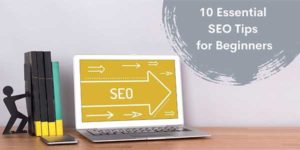
Do you want to launch a top-quality website for your small business as quickly as possible and without paying an arm and leg for it? If your answer is “yes”, then you have reached the right place. In this blog, not only you will learn how to set up a professional website for any type of business in just 7 easy steps, you will also learn how you can do it all by yourself!
Let’s get started, shall we?
Table of Contents
Step #1: Register A Domain Name
Before you get started with the actual work, you must have the website name i.e. the domain name registered. A sample domain name looks like this: www.YourCompanyName.com.
Registering a domain name is actually pretty easy and ridiculously cheap too.
Most of the website hosting service providers offer this service, which brings us to the next step:
Step #2: Pick A Website Builder And Lay The Foundation
Building a website from scratch isn’t as challenging as it may sound. In fact, if you are just a wee bit tech-savvy, you can easily build a website entirely by yourself. For this, the first thing you need to do is choose a good website builder. There are plenty to choose from including Weebly, WordPress, Shopify, etc.
Some may offer more features than others such as more templates, better tech support, etc. and some might be more expensive too. So, before you make the final decision, be sure to compare the best website builders that are available today so that you know exactly what you are getting.
Creating a website is really easy and simple with a website builder. You can start with picking a good theme which would cover most of the design work itself by automatically setting up elements like hero image, navigation bar, background image/video, spacing for product photos, typography and color palette, etc. However, you can still make all kinds of changes you want in the design with the right customization tools.
Step #3: Brand Your Website
Once your basic functioning website is ready, it’s time to do some branding work. Although you may feel you can skip this step, it’s highly recommended that you don’t.
Merely creating a website irrespective of how attractive or professional it is, won’t get you much far unless you work towards making it unique and special. This is where branding comes in.
Branding allows you to maintain consistency in your website’s design elements, boost the marketing efforts, and even makes it easier to win more customers.
Although branding itself is a broad domain on its own, what you want to start with is designing a premium and creative logo first. You can easily make one with a logo generator without doing a lot of design work yourself.
Once are done, you can simply download the design file and upload the logo to your website. You should also settle for a color palate as well as certain fonts that you want to use across the entire website including its various elements viz. eBooks, newsletters, emails, etc.

Step #4: Add A Blog To Your Website
Having a professional blog on your website serves many purposes. For starters, it can do wonders for SEO aka Search Engine Optimization which helps in attracting organic traffic and improving the website’s ranking on search engine indices. You can also educate your customers through informative blog posts which is highly recommended if you are offering technical services/products that may not be easily understood by a layman.
Adding a blog to your website should be easy if you are using a comprehensive and reputed website builder. However, what’s important is that the content you publish is of high quality, devoid of grammatical errors, and interesting enough for the reader to pay attention. So, it’s a good idea to check out a checklist for writing a killer blog post before you get to work.
Step #5: Add Product / Services Pages And A Payment System
The main purpose of your website is to sell your products or services. So, make sure you add dedicated pages for them. Learn how landing pages are designed and create as many as you need. Add all the details including prices, features, payment options, etc.
Some of the important pages that almost every website must have are:
- About us
- What we do
- FAQs
- Contact Us
- Our Products/Services
- Testimonials/Reviews
- Privacy Policy
- Terms and Conditions
Apart from these pages, you must also set up a payment system to receive the payments from your customers. A simple and easy way to do this is sign up with a platform like PayPal, Skrill, Intuit, Click2Sell, etc.
Step #6: Check If Everything Works
At this point, your website is almost ready. However, you need to make sure that everything is working properly. Some of the things you want to check include the page loading time (to see if it’s taking too long to load), payment services, formatting of the text and images, feedback form delivering the messages to your inbox properly, etc.
Also, check how your website performs on smaller devices such as smartphones and tablets. The text should be readable and navigation appropriate for the smaller screens.
Step #7: Hit The “Launch” Button
That’s it! It’s time to go live! The best way to do this is to issue a Press Release and officially announce the launch of your website. Good luck!

















Be the first to write a comment.